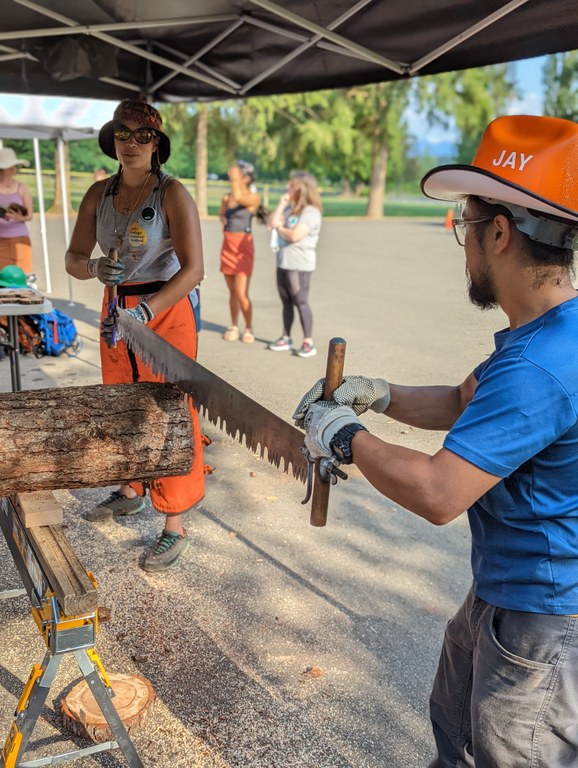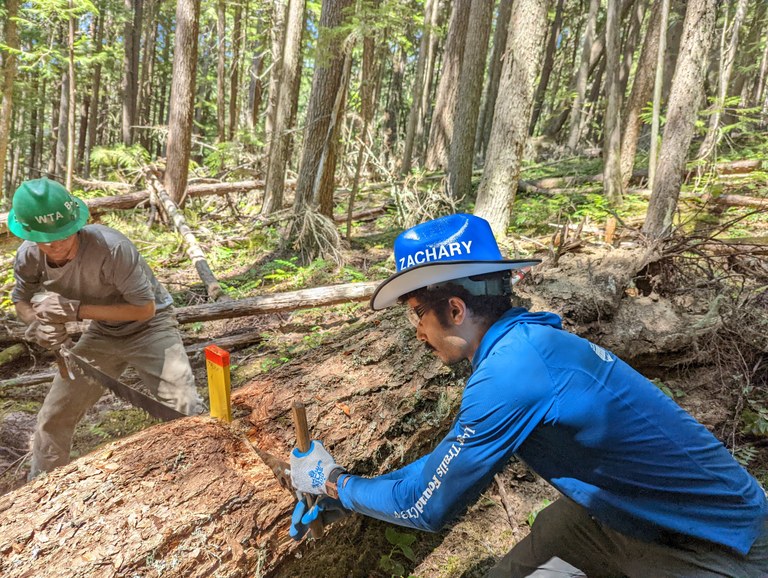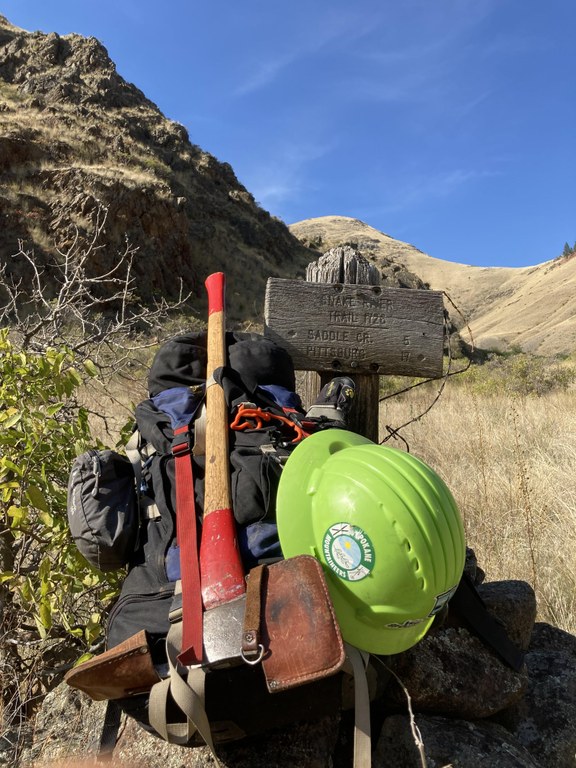 Washington Trails
Association
Washington Trails
Association
Trails for everyone, forever
From crosscut saws to Pulaskis, and from the coast to the Idaho border, WTA staff and volunteers are caring for trails with a versatile stash of tools. By Tiffany Chou and Holly Weiler
Our trail work tools really get around. Sometimes they’re teaching young trail workers how to crush rocks on a youth trail work party. On another day they’re showing folks at a festival how teamwork and a crosscut saw can help keep trails open. And some tools are versatile enough to be taken out on nearly every work party, traveling all the way from the North Cascades down to Oregon.
No matter where they are and what they’re used for, our tools are a critical part of the work we do to keep our trails safe and accessible. And just like WTA, they go where they’re needed most — all year long, and all across the state. Here’s the story of some of those tools — and the difference they made for trails — from the last year.
Kaci Darsow — youth work parties

The single jack is a smaller tool, which makes it easier to have control over, including for tasks like driving rebar or nails. The color markings are helpful in letting you know where to put your hands! Photo by Kaci Darsow.
Sometimes, the simplest tools are the handiest. A single-jack hammer is basically a small sledgehammer or mallet. It’s not something you’ll find at every trail work party but you might see it — or its big sibling, the double jack — on a construction-heavy project.
Kaci Darsow, youth trail crew leader at WTA, is a big fan of the single jack. In fact, it’s been so helpful on their trips that they’ve dubbed it the “magic jack.”
Some may underestimate the single jack because it’s not as large or powerful as something like the double jack. But Kaci loves the single jack because it’s easy to control. Even though it’s small, it can still pack a punch with the right technique. As a smaller tool, its size and weight work well in both youth and adult hands. And it’s great for youth or beginner trips because it’s a steppingstone to building up confidence and skills before trying bigger tools.

The single jack can be a powerful tool in empowering youth on trail. Photo by Kaci Darsow.
Because of how useful it is, this single jack followed Kaci on many of their youth trips last year.
On the first weeklong youth volunteer vacation last summer, the hammer made its way to West Fork Humptulips on the Olympic Peninsula, where the crew’s big project was replacing a broken puncheon, along with a few other construction projects. The single jack was used for both new construction and to fix mistakes. When the crew hammered in a few spikes that needed to be removed, the single jack was great for hammering them back out.
Then it traveled to Franklin Falls near Snoqualmie Pass for two more youth volunteer vacations — the first work party was another puncheon replacement, and the second was an old turnpike replacement. These projects involved driving a lot of spikes and rebar, and the single jack was able to shine — especially with getting rebar in initially, something that can be tricky with a larger, clumsier tool.
After that, the hammer went to Glendale Forest in North Highline — one of our Trail Next Door projects — for several youth day work parties that focused on rock work. The single jack proved its worth with rock smashing, especially if a rock needed to be shaped instead of decimated. It spent the rest of the year hanging out at Glendale, where it pulled its weight on several more youth trail work projects.
Zachary Toliver — Lost Trails Found crew, Refuge Outdoor demo, day work parties

Many folks got to try out a crosscut saw at the Refuge Outdoor Festival — and even got to take home a souvenir! Photo by Zachary Toliver.
Ever wondered what that big two-person saw used to cut down large trees is called? It’s a crosscut saw, and it gets a good amount of use from our WTA trail crews, especially after a winter of falling trees.
Zachary Toliver, former Lost Trails Found (LTF) crew leader and current South Puget Sound trails coordinator at WTA, saw a lot of crosscut use this year. Because it’s such a large saw — with the added benefit of being able to be used by either one person alone or two people at once — it’s the perfect tool for cutting through large logs, something our crews do for a number of different projects.
Zachary took one 5-foot crosscut saw on quite the ride last year.
The crosscut started the summer with our professional LTF crews’ onboarding trip at Cow Creek Meadows in the Entiat Valley region. The LTF crew members learned how to use it by spending 4 days clearing over 60 logs.
After the LTF trip, the saw took a break from trail work to take part in a crosscut demonstration at the Refuge Outdoor Festival — a community-building overnight camping event for BIPOC and allies — that WTA has been a proud sponsor of for the past several years. Interested onlookers were invited to try using a crosscut saw, then were given the small disk they cut off the demo log as a souvenir. As a larger tool that many have seen before in pictures or cartoons but not necessarily in person, the crosscut got a lot of attention at the event.
From there, the saw went on a dozen day work parties over a month to the Palisades in Mount Rainier National Park. It was a vital part of a massive project — the replacement of an old 23-foot wooden bridge.

This crosscut saw helped clear a lot of trails this year, including at this work party near Mount Rainier. Photo by Zachary Toliver.
The project used large fallen trees from the work site, and the crosscut was necessary to cut the foot-wide trees to the right length for stringers, beams that run the length of the bridge, and sills, logs anchored to the ground to hold up the stringers. The saw was also perfect for trimming the ends of the stringers to make them nice and even.
The crosscut didn’t get to rest in the fall but it did get to spend sometime at the beach at Tolmie State Park. A bunch of downed trees needed to be cleared for the creation of a temporary connector trail between the upper parking lot and trail network while the lower parking lot is closed for construction.
Then, the crosscut traveled to the Puyallup Loop Trail for a trail reroute that went through some dense forest, where it really helped with removing some logs.
And for its last outing of the season, the crosscut took a trip along I-90 to Dirty Harry’s Peak on a Climbers of Color trail work party, where an access trail was created from the main trail to Gritscone Crag to prevent climbers from creating social trails.
It was a busy year for the crosscut, and our trails and trail crews are grateful for all it was able to help accomplish.
Holly Weiler — Eastern Washington, day trips and BCRTs

The humble Pulaski is a great tool for many different projects. (Googly eyes are optional.) Photo by Holly Weiler.
Holly Weiler, WTA’s Eastern Washington regional coordinator based in Spokane, is fan of the Pulaski, a versatile trail tool that can accomplish a large variety of tasks.
The Pulaski is a tool with both an axe and adze (a perpendicular axe) on its head. It’s named for Ed Pulaski, of the historic 1910 wildfire fame.
It can be used for almost any grubbing task. (Grubbing means removing top soil or organic material while doing trail work.) The Pulaski is always invited on log-out projects because the crosscut saw training manual requires it in saw kits.
The axe end is kept sharp for chopping on a crosscut saw team. The adze end can be used for digging out narrow trail tread or repairing failing trailside drainage. Since it’s smaller than most other digging tools, it can easily get into tight places like around tree roots and in between rocks. The tool head can be turned sideways to be used as a rake to move duff and debris off the trail or to clear a drain dip. The Pulaski doesn’t accomplish each task quite as cleanly as some other tools, but it’s the best tool to serve a wide variety of purposes on trail. Plus, once it has a sheath covering its sharp parts, it can be attached to the outside of a pack for easy carrying.

The Pulaski is worth its weight for backcountry trips. Photo by Holly Weiler.
Last summer and fall, Holly carried a Pulaski to accomplish a variety of trail work tasks. The tool started its season on a logout Backcountry Response Team trip to Clackamas Mountain in the Colville National Forest. The Pulaski helped remove trees from the trail and also did a lot of work clearing trailside drainage plugged by a winter’s worth of debris. On long sections of narrow trail tread, the Pulaski was put to work widening the trail back to full trail standards.
Following that trip, the tool traveled to the Salmo-Priest Wilderness and trails near Sullivan Lake in the far northeast corner of the state. Then it made a fall trip to the Hells Canyon Recreation Collaborative, where it helped on a project (and even took a jetboat trip!) on both the Idaho and Oregon sides of the Snake River Trail. It ended the season helping to shape frozen dirt on a late November project with Spokane County Parks.
When many tools are available at a worksite, the Pulaski can be overlooked in favor of a specialty tool. But when you want to minimize pack weight by carrying just one tool that can take care of many tasks, the versatile Pulaski is perfect.
Like all of WTA’s extensive stash of tools, some of these tools spent the winter out on trail. Others took a short break, perhaps getting a little TLC, such as a sharpening. Now, they’re all ready for another year of taking care of trails all across the state. If you’d like to try any of these tools yourself, come join us on a work party.